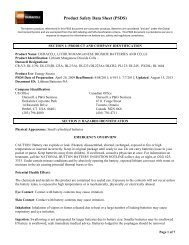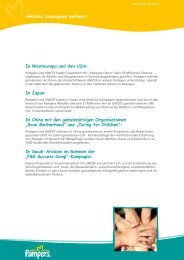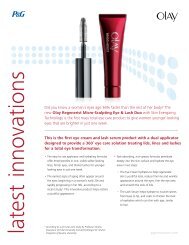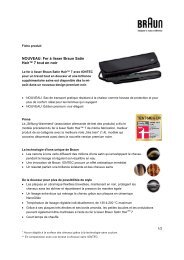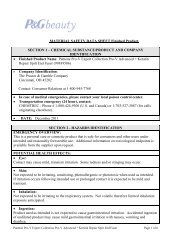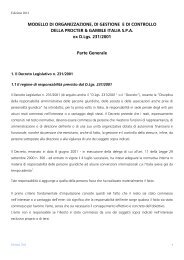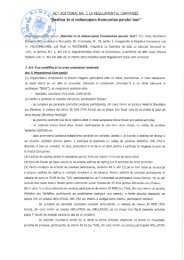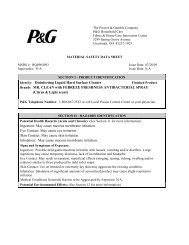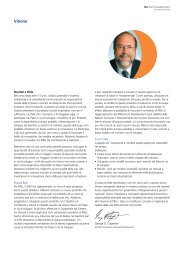P&G 2009 Annual Report – AnnualReports.com - Procter & Gamble
P&G 2009 Annual Report – AnnualReports.com - Procter & Gamble
P&G 2009 Annual Report – AnnualReports.com - Procter & Gamble
You also want an ePaper? Increase the reach of your titles
YUMPU automatically turns print PDFs into web optimized ePapers that Google loves.
Management’s Discussion and Analysis The <strong>Procter</strong> & <strong>Gamble</strong> Company 45<br />
Revenue Recognition<br />
Most of our revenue transactions represent sales of inventory. We<br />
recognize revenue when title, ownership and risk of loss transfer to<br />
the customer, which can be on the date of shipment or the date of<br />
receipt by the customer. The revenue recorded is presented net of sales<br />
and other taxes we collect on behalf of governmental authorities and<br />
includes shipping and handling costs, which generally are included in<br />
the list price to the customer. A provision for payment discounts and<br />
product return allowances is recorded as a reduction of sales within the<br />
same period that the revenue is recognized. We offer sales incentives<br />
to customers and consumers through various programs, consisting<br />
primarily of customer pricing allowances, merchandising funds and<br />
consumer coupons. The cost of these programs is recognized as<br />
incurred and recorded as a reduction of sales. Given the nature of our<br />
business, revenue recognition practices do not contain estimates that<br />
materially affect results of operations.<br />
In<strong>com</strong>e Taxes<br />
Our annual tax rate is determined based on our in<strong>com</strong>e, statutory tax<br />
rates and the tax impacts of items treated differently for tax purposes<br />
than for financial reporting purposes. Tax law requires certain items<br />
to be included in the tax return at different times than the items are<br />
reflected in the financial statements. Some of these differences are<br />
permanent, such as expenses that are not deductible in our tax return,<br />
and some differences are temporary, reversing over time, such as<br />
depreciation expense. These temporary differences create deferred tax<br />
assets and liabilities.<br />
Deferred tax assets generally represent the tax effect of items that can<br />
be used as a tax deduction or credit in future years for which we have<br />
already recorded the tax benefit in our in<strong>com</strong>e statement. Deferred tax<br />
liabilities generally represent tax expense recognized in our financial<br />
statements for which payment has been deferred, or the tax effect of<br />
expenditures for which a deduction has already been taken in our tax<br />
return but has not yet been recognized in our financial statements or<br />
assets recorded at fair value in business <strong>com</strong>binations for which there<br />
was no corresponding tax basis adjustment.<br />
Inherent in determining our annual tax rate are judgments regarding<br />
business plans, planning opportunities and expectations about future<br />
out<strong>com</strong>es. Realization of certain deferred tax assets is dependent upon<br />
generating sufficient taxable in<strong>com</strong>e in the appropriate jurisdiction prior<br />
to the expiration of the carry-forward periods. Although realization is<br />
not assured, management believes it is more likely than not that our<br />
deferred tax assets, net of valuation allowances, will be realized.<br />
We operate in multiple jurisdictions with <strong>com</strong>plex regulatory environments<br />
subject to different interpretations by the taxpayer and respective<br />
governmental taxing authorities. In certain of these jurisdictions we<br />
may take positions that management believes are supportable, but<br />
are potentially subject to successful challenge by the applicable taxing<br />
authority. We evaluate our tax positions and establish liabilities in<br />
accordance with the applicable accounting guidance on uncertainty<br />
in in<strong>com</strong>e taxes. We review these tax uncertainties in light of the<br />
changing facts and circumstances, such as the progress of tax audits,<br />
and adjust them accordingly. We have a number of audits in process<br />
in various jurisdictions. Although the resolution of these tax positions<br />
is uncertain, based on currently available information, we believe that<br />
the ultimate out<strong>com</strong>es will not have a material adverse effect on our<br />
financial position, results of operations or cash flows.<br />
Because there are a number of estimates and assumptions inherent in<br />
calculating the various <strong>com</strong>ponents of our tax provision, certain<br />
changes or future events such as changes in tax legislation, geographic<br />
mix of earnings, <strong>com</strong>pletion of tax audits or earnings repatriation plans<br />
could have an impact on those estimates and our effective tax rate.<br />
Employee Benefits<br />
We sponsor various post-employment benefits throughout the world.<br />
These include pension plans, both defined contribution plans and<br />
defined benefit plans, and other post-employment benefit (OPEB) plans,<br />
consisting primarily of health care and life insurance for retirees. For<br />
accounting purposes, the defined benefit and OPEB plans require<br />
assumptions to estimate the projected and accumulated benefit<br />
obligations, including the following variables: discount rate; expected<br />
salary increases; certain employee-related factors, such as turnover,<br />
retirement age and mortality; expected return on assets and health<br />
care cost trend rates. These and other assumptions affect the annual<br />
expense and obligations recognized for the underlying plans. Our<br />
assumptions reflect our historical experiences and management’s<br />
best judgment regarding future expectations. In accordance with<br />
U.S. GAAP, the net amount by which actual results differ from our<br />
assumptions is deferred. If this net deferred amount exceeds 10% of<br />
the greater of plan assets or liabilities, a portion of the deferred<br />
amount is included in expense for the following year. The cost or<br />
benefit of plan changes, such as increasing or decreasing benefits for<br />
prior employee service (prior service cost), is deferred and included in<br />
expense on a straight-line basis over the average remaining service<br />
period of the employees expected to receive benefits.<br />
The expected return on plan assets assumption is important, since many<br />
of our defined benefit plans and our primary OPEB plan are funded.<br />
The process for setting the expected rates of return is described in<br />
Note 8 to the Consolidated Financial Statements. For <strong>2009</strong>, the average<br />
return on assets assumptions for pension plan assets andOPEB assets<br />
were 7.4% and 9.3%, respectively. A change in the rate of return of<br />
0.5% for both pension and OPEB assets would impact annual benefit<br />
expense by less than $40 million after tax.<br />
Since pension and OPEB liabilities are measured on a discounted basis,<br />
the discount rate is a significant assumption. Discount rates used for<br />
our U.S. defined benefit and OPEB plans are based on a yield curve<br />
constructed from a portfolio of high quality bonds for which the timing<br />
and amount of cash outflows approximate the estimated payouts of<br />
the plan. For our international plans, the discount rates are set by<br />
benchmarking against investment grade corporate bonds rated AA<br />
or better. The average discount rate on the defined benefit pension<br />
plans of 6.0% represents a weighted average of local rates in countries<br />
where such plans exist. A 0.5% change in the discount rate would<br />
impact annual after-tax defined benefit pension expense by less than



